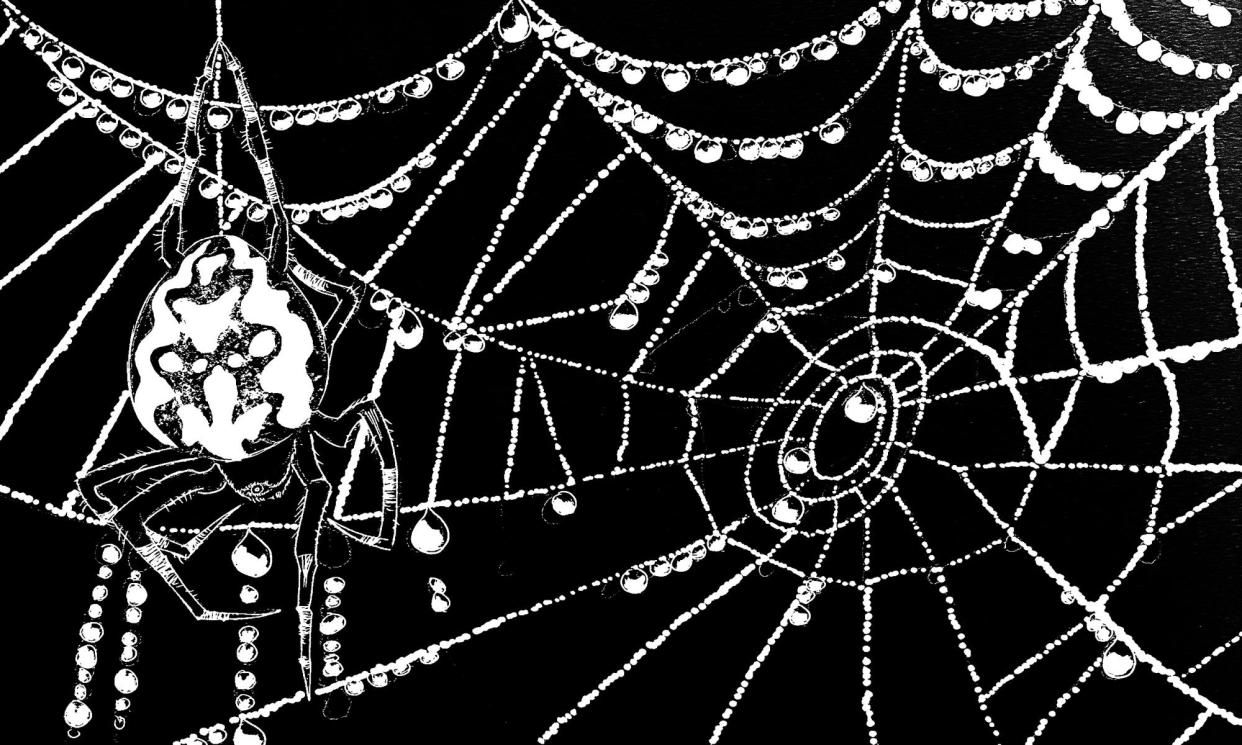Poem of the week: Marbled Orb Weaver by Matt Howard

Marbled Orb Weaver
This cling of stickiest silk
from the spirals of the web
and the tensile strength
of its signal thread –
that whole scheme set,
dew beading each node.
All her night work
now undone by my scythe
with one pass at the end
of this fresh-cut, rough acre ride
of four-foot-tall reed sweet-grass.
So she’s here, in open fen,
her two centimetres scrambling
over the cuttings,
there’s her egg-bloated
greeny-cream abdomen.
Look how she can’t give in –
Jurassic proximity
of brain, venom gland, fang,
her book lung’s unreadable
breathing; her palps,
each segment of forelegs
and the fused cephalothorax raised —
that fixed eye stratum
of a mountain unmoved
by any imposition, let alone
the chewed-raw-to-the-quick
of this fingertip.
From Matt Howard’s new collection, Broadlands, Marbled Orb Weaver doesn’t attempt any obviously spidery visual effects (Howard isn’t that kind of poet) but, especially in the first 12 lines, depends on an informal, impressionistic syntax to weave between periphery and centre, web and spider, spider and human.
The poem begins with the web’s tactility – “this cling of stickiest silk” and the pull of the “signal thread”: (this is the thread attached to the centre of the web which tells the spider when her prey has been captured). The verbal pattern has its own “tensile strength” and sticking power. It goes on to present a traditional picture of the spiral web, complete with dew-drops “beading each node” and the perfection of “that whole scheme set”. Then, the continuation of a new sentence is torn off, with a jolt that mimics the speaker’s accidental shearing of the web: “All her night work / now undone by my scythe.” Howard’s emotion here is implicit, the style only edging towards anthropomorphism. Robert Burns’s mouse would be only a distant literary ancestor.
The second stanza soon merges regret for the imbalance of power (“one pass” of a scythe, or, indeed, a hand, is all it takes to undo a night of spider-weaving) into the exhilaration of the work that till now has absorbed the narrator in “this fresh-cut, rough acre ride / of four-foot-tall reed sweet-grass.” The Norfolk wetland is territory shared by this man and this spider, and now the spider has become the new, sharp focus of the dominant human. He seizes the educative moment, taking the opportunity to investigate, and show his readers what the spider’s “two centimetres” consist of. Although the anatomical details which ensue are enthralling as words and as information, it’s the instantly memorable sight of the little creature “scrambling / over the cuttings” which grounds the anatomical list beyond its instructive function.
After observing an important detail, “her egg-bloated / greeny cream abdomen”, the poem pauses on an observation which applies to many of the creatures, perhaps all, that Howard investigates in this outstanding collection of nature poems: “Look how she can’t give in” – and this survival imperative is shown to be the function of the body in all its compact and intense organisation.
Howard judges expertly on when to let the name of a body-part simply exist for itself, and when to elaborate slightly. So there’s “Jurassic” to heighten the ancient and powerful proximity of “brain, venom gland, fang”, and a little metaphorical playfulness drawn from the term “book lung” with its “unreadable / breathing”. Reading between complexities, from the biological term to the tiny body that connects the parts, we seem to get a double-rich helping of imagery.
In the fourth of the seven-line stanzas, and the last segmented sentence of the poem, the spider seems to become larger and denser. Howard never sentimentalises the natural world, though he appreciates the qualities a human being can engage with (conversely, when he writes about people, he often finds a zoomorphic connection). He looks at the ugliness of nature, too, and the sheer strangeness. Here, “that fixed eye stratum / of a mountain unmoved” is a figure that gives the tiny spider a relentless, predatory presence and force.
It seems, as the poem closes, that the speaker has touched, or tried to touch, the spider – this one, or another – in the course of his work. Perhaps his finger once tested a marbled orb weaver’s signal thread? The spider herself is entirely “unmoved” by the fingertip the speaker presents. Unexpectedly, it’s the finger of a voracious nail-biter. Nail-biting suggests tension and anxiety, and perhaps testifies to the constant dilemma-dance of those who have to make the life-or-death decisions sometimes needed for good husbandry, and who must possess the naturalist’s particular combination of surgical, small-muscle precision and whole-body capacity for the heavy work.
Howard is meticulous about detail, even providing grid references in the titles of some of his ornithological poems. He explains: “When you go out nest surveying you note them down and add to the nest record. So for me it’s another part of each of those poems, the idea that this particular nest, these eggs on this date etc all matter, that those individuals, no matter how relatively commonplace, all of it matters. A sense of each such encounter ‘in the field’ being a poem, that such simple ecological work blends into poetry if you see what I mean’.” The connection made here between data formally expressed and shared with the research community, and the language and imagery of the poem (“all matter”) is what makes Howard’s work on the page an exceptional contribution to the ecopoetry genre, and to poetry itself.
• Matt Howard, based in Norwich, combines a variety of poetry projects with work for the RSPB: there are more details on his website.


